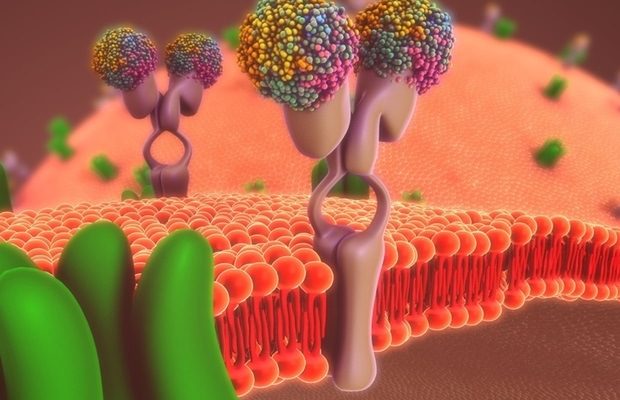Scientists at St. Jude Children's Research Hospital and the University of Texas Southwestern Medical Center studied the structure and function of a transporter involved in cancer and immunity. They captured six structures of the transporter, including when it was bound to an inhibitor, providing unprecedented insight into how it works. The findings, published in Cell, have implications for drug development.
Transporters escort substances across the cell membrane so that they can carry out their functions. Sphingosine-1-phosphate (S1P) is an important signaling molecule that regulates the immune system, blood vessel formation, auditory function and the integrity of epithelial and endothelial membranes. It aids the progression and survival of cancer cells through chemoresistance and metastasis.
The S1P molecule is synthesized inside the cell but must cross the cell membrane to carry out its signaling duties. Spinster homolog 2 (Spns2) is an S1P transporter; this protein sits on the membrane and opens toward the inside of the cell, binds to S1P, and then opens toward the outside of the cell to release S1P.
Research has shown that altering Spns2 activity can have therapeutic effects against cancer, inflammation and immune diseases. However, the transport mechanism of Spns2 and how to inhibit it was unclear.
We hope our structural information will pave the way for the development of improved, more specific small molecules with higher potency against Spns2 in the future. I think there is huge potential for inhibiting the Spns2 transporter therapeutically."
Chia-Hsueh Lee, Ph.D., co-corresponding author, St. Jude Department of Structural Biology
Cryo-EM structures explain how the transporter works
The researchers obtained six cryo-Electron Microscopy (cryo-EM) structures of Spns2, including two functionally relevant intermediate conformations (shapes) that link the inward (inside a cell) and outward (outside the cell) facing states. The findings reveal the structural basis of the S1P transport cycle.
"I think these results are quite satisfying because capturing a particular transporter's major conformations is rare," Lee added. "By comparing those different structures, we have a very detailed picture of how this transporter captures the S1P signaling molecule."
"We used cryo-EM to capture the structure of this transporter and discover how it moves S1P to the outside of the cells," said co-first author Shahbaz Ahmed, Ph.D., St. Jude Department of Structural Biology. "We also studied an inhibitor and provided the structural data for how it binds the transporter and blocks its activity."
The researchers studied how Spns2 binds to the inhibitor 16d, a specific small molecule that has demonstrated very few off-target effects. The researchers found that 16d stops transport activity by locking Spns2 in the inward-facing state. The work aids the development of advanced Spns2 inhibitors.
"This inhibitor actually blocks the protein in an inward conformation. When the protein is blocked, it cannot transition from inward to outward-facing, and it cannot throw the signaling molecule from inside to outside the cells," Lee said. "In addition, the inhibitor physically blocks the binding of the signaling molecule because they both bind to the same cavity."
Cell surface molecules are an attractive target for drug development. G-protein coupled receptors (GPCRs) are a type of cell surface protein that is the target of one-third of all Food and Drug Administration-approved therapeutics. As cell surface molecules, transporters may have similar potential for drug development. Therefore, understanding their structure and function has the potential to make significant inroads for improving disease treatment.
"Our work reveals the atomic details of the Spns2-mediated S1P transport cycle, which is important to understanding how this signaling sphingolipid circulates in our immune system," said co-corresponding author Xiaochun Li, Ph.D., Departments of Molecular Genetics and Biophysics, University of Texas Southwestern Medical Center. "The structures also help the development of potent Spns2 inhibitors, which may contribute to cancer and autoimmune disease treatment."
Authors and funding
The study's other first authors are Hongwen Chen, University of Texas Southwestern Medical Center, and Hongtu Zhao, St. Jude. Other authors are Nadia Elghobashi-Meinhardt, Technical University Berlin; Jae Hun Kim and Jeffrey McDonald, University of Texas Southwestern Medical Center; and Yaxin Dai, St. Jude.
The study was supported by grants from the National Institutes of Health (P01HL160487, 1P30DK127984, R01GM134343 and R01GM143282), the Welch Foundation (I-1957), the Damon Runyon Cancer Research Foundation (DRR-53S-19) and ALSAC, the fundraising and awareness organization of St. Jude.
St. Jude Children's Research Hospital
Chen, H., et al. (2023) Structural and Functional insights into Spns2-mediated transport of sphingosine-1-phosphate. Cell. doi.org/10.1016/j.cell.2023.04.028.
Posted in: Molecular & Structural Biology | Cell Biology
Tags: AIDS, Autoimmune Disease, Blood, Blood Vessel, Cancer, Cell, Cell Membrane, Children, Electron, Electron Microscopy, Food, Genetics, G-Protein, Hospital, Immune System, immunity, Inflammation, Membrane, Metastasis, Microscopy, Molecule, pH, Protein, Research, Sickle Cell Disease, Small Molecules, Structural Biology, Therapeutics
Source: Read Full Article
